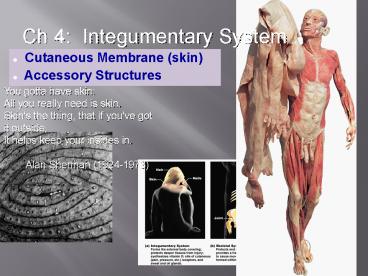Cutaneous Membrane skin PowerPoint PPT Presentation
1 / 31
Title: Cutaneous Membrane skin
1
Ch 4 Integumentary System
- Cutaneous Membrane (skin)
- Accessory Structures
You gotta have skinAll you really need is
skin.Skin's the thing, that if you've got it
outside,It helps keep your insides in.
Alan Sherman (1924-1973)
2
Two Major Subdivisions
- Cutaneous Membrane
- Epidermis
- Dermis
- Hypodermis
- Accessory Structures
- Excretory glands (?)
- Hair
- Nails
3
(No Transcript)
4
Made up of all 4 tissue types
5
Epidermis
- Type of Epithelium
- Avascular
- Different layers (strata)
- 4 layers in thin skin
- 5 layers in thick skin
6
Stratum Germinativum
- Cell types
- Stem cells (basal cells)
- Melanocytes
- Merkel cells (touch receptors in hairless skin
only)
stratum basale
Stratum germinativum
Innermost, single layer
7
Stratum Spinosum
- Stem cell daughter cells (some can still divide)
- Establishment of Desmosomes
- The desmosomes create the spines as artifact
pulls the cells apart
Stratum spinosum
Several cells thick
8
Stratum Granulosum
- Cells displaced from stratum spinosum
? Keratinocytes - Production of keratohyalin and keratin fibers
- Cells start to die. Dehydration leaves
interlocked layers of keratin and keratohyalin
Small granules of keratin
Stratum granulosum
9
Stratum Lucidum
- In thick skin, i.e., palms of hands and soles
of feet - Cells do not stain well ? clear (lucid) looking
Mostly keratin
Stratum lucidum
10
Stratum Corneum
- Many layers of flattened, dead cells, filled with
keratin - Continually sloughed
- Water-resistant but not water proof (? insensible
perspiration) - Relatively dry - advantage?
- Keratinization occurs everywhere except for
anterior surface of eye
Stratum corneum
15-30 layers (much thicker in thick skin)
11
Thin vs. Thick Skin
Refers to epidermis
- Up to 6 x thicker
- Where??
- Average 0.08 mm
- Most of body
12
Contour of skin surface follows pattern of
epidermal ridges.
c
c
13
Skin Color
Depends on 3 pigments
- Hemoglobin (dermal blood supply)
- Reddish tones
- Pale, due to?
- Bluish (?), due to?
- Melanin
- Produced by melanocytes of stratum basale
- Carotene
- Obtained from plant foods
14
Melanocytes
Function ? UV protection?
Number of melanocytes same in all people,
production levels differ !
15
Albinism
Vitiligo
16
Dermis
- 1. Papillary layer Areolar (loose) c.t.
- 2. Reticular layer dense irregular c.t.
17
C.T Review
18
1. Papillary Layer
- Dermal papillae project between epidermal ridges.
- Consist of
- Loose c.t.
- Capillaries
- Tactile receptors
M?
19
2. Reticular Layer
- Consist of
- Dense irregular c.t.
- Accessory Structures
- Hair
- Glands
- Nerves
- Blood Supply
20
Hypodermis
- 2 other names
- Subcutaneous Layer (subcutis)
- Superficial fascia
- Indistinct boundary (c.t. fibers interwoven)
- Loose c.t.
- Function
- Stabilization of skin while allowing for
independent movement
21
Clinical Brief
- Wrinkles
- Stretch marks (lineae albicantes)
- Decubitus
- Transdermal medication
- Advantage and disadvantage?
- Examples?
- Hypodermic needles
Lines of cleavage
22
Accessory Structures Hair Follicles Hair
- 5 million hairs/human body. (98 not on top of
head) - Three hair types (vellus intermediate
terminal) - Function ?
- Hair color
- Growth cycle
23
Holocrine secretion
24
Skin Glands1) Sebaceous Glands
- Holocrine secretion
- Sebum discharged mostly into hair follicles
- (lubrication bactericidal)
Sebaceous follicles, Large sebaceous glands,
discharge directly to epidermis Folliculitis
furuncle (boil) acne
25
2) Apocrine Sweat Glands
- Empty into hair follicle
- Location armpits, groin, nipples
- Viscous, cloudy secretion ? good nutrient source
for bacteria (odor !!) - Secretion may contain Pheromones
- Secretion begins at puberty and is stimulated
during emotional distress (cold sweat)
26
Apocrine Sweat Glands
27
3) Eccrine Sweat Glands
- Merocrine secretion
- Empty directly onto skin surface
- Location most all over body (esp. abundant on
palms soles 500/cm2) - Clear, watery secretion (99 H2O rest NaCl
some waste products) - Sensible perspiration Function ?
28
For purpose of completion
- Other integumentary Glands
- Mammary glands Modified apocrine sweat glands
- Ceruminous glands Modified sweat glands in ears
29
Nails
30
Skin Pathology
Melanoma
31
Skin Cancers
- Basal Cell Carcinoma (Epithelioma)
- Most common, not malignant
- Squamous Cell CA
- Stratum spinosum
- Melanoma
BCC
SCC
Iris Melanoma
32
Skin and Aging Process
33
(No Transcript)
34
Decubitus

